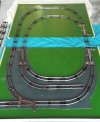I'm relatively new to G scale so please excuse an elementary question. Mods please move this if posted in the wrong place.
I'm about to start building a permanent layout in part of my loft with overall dimensions of baseboards of approx 7m x 3.5m with a central operating area accessed via a loft hatch. I know this is small for G Scale but the garden is simply not level enough - and I need an indoor hobby for winter weather which the grandchildren can also enjoy.
I would ideally like to build a two-level layout with a looped-eight design but, due to the shallow roof angle, the width is reduced to 2.5m if clearance to accommodate an upper level of track is required.
I have been playing with designs using Anyrail (excellent program) and find that the absolute minimum (calculated) gradient is 3% if I am to leave headroom of 255mm (inc baseboard) for trains on the lower level and then this only allows two-level running at one end of the layout, the rest being taken up by graded track which severely restricts design freedom.
I've been carrying out some 'scientific' tests using a 4m length of straight track on an inclined trackbed and four LGB small bogie coaches hauled by various LGB and Bachman locos. The smallest loco I have is a LGB Feldbahn 0-4-0 and this can only manage one coach without slipping to a standstill. The LGB Stainz seems a lot better and can manage all four coaches but very careful (DCC) control is required to prevent slipping and the 0-6-0 six-coupled LGB diesel is not significantly better. All are fitted with Zimo decoders with 128-step motor control and none are fitted with any type of traction tyre.
So, it seems that if I really want a two-level layout, I will have to accept 3% gradients and some sort of traction enhancer (ie traction tyres or something like Bullfrog Snot). Does anyone have any advice? Do any of the traction enhancers really work and, if so, does anyone have any comparative performance data available?
Or perhaps I should just go for a single level layout - which is probably less work.......................
I'm about to start building a permanent layout in part of my loft with overall dimensions of baseboards of approx 7m x 3.5m with a central operating area accessed via a loft hatch. I know this is small for G Scale but the garden is simply not level enough - and I need an indoor hobby for winter weather which the grandchildren can also enjoy.
I would ideally like to build a two-level layout with a looped-eight design but, due to the shallow roof angle, the width is reduced to 2.5m if clearance to accommodate an upper level of track is required.
I have been playing with designs using Anyrail (excellent program) and find that the absolute minimum (calculated) gradient is 3% if I am to leave headroom of 255mm (inc baseboard) for trains on the lower level and then this only allows two-level running at one end of the layout, the rest being taken up by graded track which severely restricts design freedom.
I've been carrying out some 'scientific' tests using a 4m length of straight track on an inclined trackbed and four LGB small bogie coaches hauled by various LGB and Bachman locos. The smallest loco I have is a LGB Feldbahn 0-4-0 and this can only manage one coach without slipping to a standstill. The LGB Stainz seems a lot better and can manage all four coaches but very careful (DCC) control is required to prevent slipping and the 0-6-0 six-coupled LGB diesel is not significantly better. All are fitted with Zimo decoders with 128-step motor control and none are fitted with any type of traction tyre.
So, it seems that if I really want a two-level layout, I will have to accept 3% gradients and some sort of traction enhancer (ie traction tyres or something like Bullfrog Snot). Does anyone have any advice? Do any of the traction enhancers really work and, if so, does anyone have any comparative performance data available?
Or perhaps I should just go for a single level layout - which is probably less work.......................

